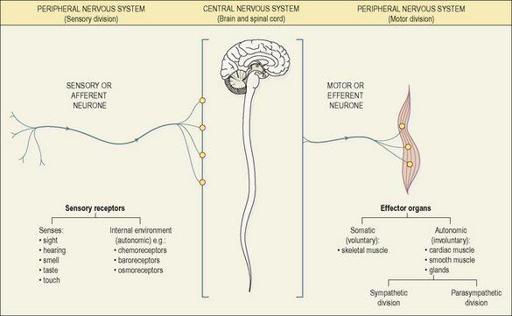Ross & Wilson Anatomy and Physiology in Health and Illness (63 page)
Read Ross & Wilson Anatomy and Physiology in Health and Illness Online
Authors: Anne Waugh,Allison Grant
Tags: #Medical, #Nursing, #General, #Anatomy

Enlargement of the gland is associated with some autoimmune diseases, such as thyrotoxicosis and Addison’s disease.
Tumours are rare, although pressure caused by enlargement of the gland may damage or interfere with the functions of adjacent structures, e.g. the trachea, oesophagus or veins in the neck.
In myasthenia gravis (
p. 376
), most patients have either thymic hyperplasia (the majority) or thymoma (a minority), although the role of thymic function in this disorder is not understood.
For a range of self-assessment exercises on the topics in this chapter, visit
www.rossandwilson.com
.
CHAPTER 7
The nervous system
Cells and tissues of the nervous system
139
Neurones
139
Nerves
142
Neuroglia
142
Response of nervous tissue to injury
144
Central nervous system
145
The meninges and cerebrospinal fluid (CSF)
145
The meninges
145
Ventricles of the brain and the cerebrospinal fluid
146
Brain
148
Blood supply to the brain
148
Cerebrum
148
Diencephalon
152
Brain stem
153
Cerebellum
154
Spinal cord
154
Grey matter
155
White matter
156
Peripheral nervous system
158
Spinal nerves
159
Thoracic nerves
164
Cranial nerves
164
Autonomic nervous system
167
Disorders of the brain
172
Increased intracranial pressure
172
Head injuries
173
Cerebral hypoxia
174
Stroke (cerebrovascular disease)
175
Dementia
176
Parkinson’s disease
176
Effects of poisons on the brain
176
Infections of the central nervous system
177
Bacterial infections
177
Viral infections
177
Demyelinating diseases
178
Multiple sclerosis (MS)
178
Acute disseminated encephalomyelitis
179
Diseases of the spinal cord
179
Motor neurones
179
Sensory neurones
180
Mixed motor and sensory conditions
180
Diseases of peripheral nerves
181
Peripheral neuropathy
181
Guillain–Barré syndrome
181
Bell’s palsy
181
Developmental abnormalities of the nervous system
182
Spina bifida
182
Hydrocephalus
182
Tumours of the nervous system
182
ANIMATIONS
7.1
Divisions of the nervous system
138
7.2
The neurone
139
7.3
The nerve impulse
140
7.4
The synapse
141
7.5
Brain ventricles
146
7.6
Main parts of the brain
148
7.7
Areas of the brain that control body functions
148
7.8
Vertebral column and spinal nerves showing nerve roots
155
7.9
Reflex arc of patellar impulse
158
7.10
Cranial nerves
164
7.11
Impulse conduction in the autonomic nervous system
167
7.12
Comparison of autonomic and somatic conduction system pathways
167
7.13
Autonomic neurotransmitters
167
7.14
Functions of the sympathetic nervous system
170
7.15
Functions of the parasympathetic nervous system
170
7.16
Haematomas
174
7.17
Thromboembolic stroke
175
7.18
Parkinson’s disease
176
The nervous system detects and responds to changes inside and outside the body. Together with the endocrine system, it controls many vital aspects of body function and maintains homeostasis. To this end the nervous system provides an immediate response while endocrine activity is, in the main, slower and more prolonged (
Ch. 9
).
The nervous system consists of the brain, the spinal cord and peripheral nerves. The structure and organisation of the tissues that form these components enables rapid communication between different parts of the body.
Response to changes in the internal environment regulates essential involuntary functions, such as respiration and blood pressure. Response to changes in the external environment maintains posture and other voluntary activities.
For descriptive purposes the parts of the nervous system are grouped as follows:
•
the
central nervous system
(CNS), consisting of the brain and the spinal cord
•
the
peripheral nervous system
(PNS) consisting of all the nerves outside the brain and spinal cord.
The PNS comprises paired cranial and sacral nerves – some of these are sensory (afferent), some are motor (efferent) and some mixed. It is useful to consider two functional parts within the PNS:
•
the sensory division
•
the motor division (
Fig. 7.1
).


